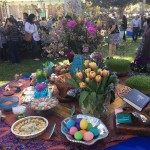This post was updated on March 15 at 2:07 p.m.
As Iranians cleaned their homes and bought new clothes to celebrate the Iranian New Year, UCLA played host for the first time to the Farhang Foundation’s ninth annual celebration of Nowruz at Royce Hall and Dickson Court on campus Sunday.
Iranian New Year, also known as Nowruz means “New Day” in Farsi. Iranians consider Nowruz the largest – and the most colorful – celebration of the year, and it traditionally aligns with the astronomical start to spring when the sun enters the sign of the Ram.
The Nowruz celebration stretches over a period of 13 days and has its origins in Zoroastrianism, an ancient Persian religion that came before the advent of Islam.
[Related: Iranian Student Group at UCLA holds annual culture show]
“Nowruz represents the new year. There are a lot of cultural traditions that we abide by, such as setting up the haft-seen, which is a table with specific items that represent new beginnings,” said Amir Rahimdel, a third-year biology student.
As I walked into the celebration, the festivities were in full swing complete with food trucks, dancers, musicians, decorations and a variety of children’s activities.
Leila Shaygan, a first-year political science student, said the event is focused around friends, family and being around loved ones.
“Everyone celebrates differently – my family does a countdown,” Shaygan said. “There are programs on TV that will do the countdown, so we’ll all be around each other, usually dressed up. Thirteen days after, there’s a big celebration, usually at a park with dancers and food, and that marks the end of the new year.”
There was also a haft-seen, which is a major tradition of Nowruz, according to the Nowruz event flyer. The haft-seen is an altar that includes seven ancient items starting with the letter ‘s’, and they correspond to seven divine creations or immortals.
“For example, we have a bowl of fish, we have the Quran, Sabzeh – which is wheatgrass – and at the end of the celebration tradition says that we have to make a wish and throw the wheatgrass into a bowl of water to wish luck into the new year,” Rahimdel said.
The Quran, as well as the bowl of fish, is not included as one of the seven items comprising the altar, since the haft-seen is traditionally nonreligious and celebrated by Iranians of all religions and backgrounds. However, they and other items can be used as ornaments or additional accents to the table piece.
[ICYMI: Pourdavoud Center for ancient Iranian studies to launch spring quarter]
In light of the travel bans passed by President Donald Trump, some members of the Iranian community have remained optimistic.
“I don’t think (celebrating Nowruz now) is any different from celebrating in the past, if not more elaborate and exciting, because we do know that our culture has been put in the spotlight, but we’re not afraid to carry on our traditions,” said Denise Miresmaili, a third-year biology student. “We want to make sure our culture is viewed in a positive light.”
One aspect of the celebration that stood out to me was the large number of family and friend groups who took the celebration to heart and were spending time enjoying the festivities with one another. At other holiday festivities that I’ve attended, it was common to see people hunched over their phones, avoiding interaction – exactly the opposite of what was happening at the celebration.
“Nowruz is all about celebrating the past year’s goodness and what we can change in the following year to make ourselves better,” said Nima Torbaty, a fourth-year English and Iranian studies student. “It’s about family, friends, inclusiveness, happiness and freedom.”

With the onset of spring and the Iranian New Year, amid the economic hardship inside, and diasporic societies everywhere around the world, Iranian citizens celebrate with the hope of a forward perspective for the good year to come, the year of the end of mullahs. The suppressed people of Iran deserve to live in a free and democratic society, which is key to peace and stability in the region. It is the only way of uprooting Islamic fundamentalism as a global threat.